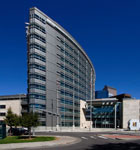 Mention sustainability to Al Skodowski, and he’s likely to respond with a wry smile. “The reality is that we’ve been doing sustainability for a long time,” he says. “We just haven’t called it as such.” For nearly a decade, the now senior vice president of sustainability has managed the huge portfolio held by Houston-based Transwestern, one of the largest privately held commercial-real estate firms in the United States. The company’s strong commitment to sustainability is evident from its 206 Energy Star- and LEED-certified properties, and in the past 12 months its energy-management practices were responsible for avoiding 3,769 metric tons of carbon-dioxide emissions—equal to removing 721 vehicles from our roads. Here, Skodowski details the corporate strategies that figure so prominently in Transwestern’s drive for sustainability.
Mention sustainability to Al Skodowski, and he’s likely to respond with a wry smile. “The reality is that we’ve been doing sustainability for a long time,” he says. “We just haven’t called it as such.” For nearly a decade, the now senior vice president of sustainability has managed the huge portfolio held by Houston-based Transwestern, one of the largest privately held commercial-real estate firms in the United States. The company’s strong commitment to sustainability is evident from its 206 Energy Star- and LEED-certified properties, and in the past 12 months its energy-management practices were responsible for avoiding 3,769 metric tons of carbon-dioxide emissions—equal to removing 721 vehicles from our roads. Here, Skodowski details the corporate strategies that figure so prominently in Transwestern’s drive for sustainability.
Focus on preventive maintenance. Preventive maintenance is what we called sustainability prior to the rise of the real estate industry’s green movement nearly a decade ago. Whether it is a new project or an existing building, we begin by examining all of the structural systems—from heating and air-conditioning to electrical and plumbing—to determine if all of the equipment is running the way it is supposed to. Simply by bringing an air-flow system up to top efficiency for instance, property owners realize considerable cost savings. Higher-performing equipment also greatly reduces pollutants expelled into the environment. By enabling building systems to run at optimum levels, everyone benefits ecologically and financially.
Upgrade for efficiency. Sometimes there is no other choice but to replace equipment. A boiler may simply be too old to improve its operations. Consequently, we look to install or equip systems that have the highest Energy Star rating and sustainability factors. Sometimes this approach has additional benefits. At Pennzoil Place [in Houston], we retrofitted spaces with more efficient lighting. Consequently air-conditioning costs were reduced because the newer lighting systems generated less heat. The result can be anywhere from 10 to 15 percent in cost savings.
Utilize certification. We strive for LEED certification because it works in our favor. LEED criteria frequently mandate reduced water usage. By installing low-flow water systems at Penzoil Place, we lowered water usage from 3.5 gallons to 1.28 gallons [per] flush. Efficient urinals brought down water content from 1.4 gallons to 1 pint. At the same time, fitting a water-catchment system in a parking garage—so that runoff from the roof can be used to irrigate landscaping or cool generators—figures highly in LEED scoring.
Do the math. At Wellington Webb, a project we managed for the city of Denver, our team reused furniture and green-based janitorial and paper supplies, [which] meant increased LEED points. Consequently, the project received LEED Gold status. We were also able to identify inexpensive operational and maintenance changes that could be adopted at other city of Denver operational facilities. Why is this important? Because more building owners and tenants realize that higher LEED certifications translate into greater savings in energy and utility costs—something which reflects directly onto their bottom line.
Spread the good word. We’ve not only proven the commercial effectiveness of sustainability; [we’ve] also demonstrated that everyone benefits from this growing movement. We’re making the case that it leads to a better global environment.

